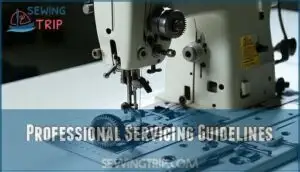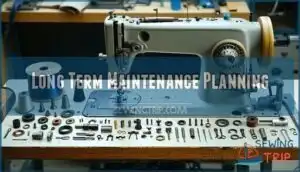This site is supported by our readers. We may earn a commission, at no cost to you, if you purchase through links.
 Your sewing machine maintenance schedule keeps your stitching buddy purring like a content cat.
Your sewing machine maintenance schedule keeps your stitching buddy purring like a content cat.
Daily tasks include wiping down surfaces, removing lint from the bobbin area, and checking your needle’s sharpness.
Weekly, you’ll deep clean feed dogs and oil moving parts according to your manual’s guidance.
Monthly maintenance involves cleaning tension disks, adjusting thread tension, and inspecting the presser foot for wear.
Annual professional servicing catches issues before they become expensive headaches.
Think of it as preventive medicine for your machine – a little care now saves major repairs later.
Following this routine prevents those frustrating mid-project breakdowns that make you want to throw fabric across the room, and it is considered a little care that helps in saving major repairs, which is like having preventive medicine, and doing annual professional servicing is key, and also doing daily tasks.
Table Of Contents
Key Takeaways
- You’ll keep your machine running smoothly by following a simple routine: clean daily (wipe surfaces, remove lint), maintain weekly (deep clean feed dogs, oil parts), and inspect monthly (check tension, clean bobbin assembly).
- You should replace your needle weekly or after every project since it’s the hardest-working part of your machine – a dull or bent needle creates skipped stitches and poor stitch quality.
- You can prevent costly breakdowns by scheduling professional servicing every two years, which costs around $55-$65 and includes timing adjustments and internal cleaning you can’t do at home.
- You’ll extend your machine’s lifespan significantly by using only proper sewing machine oil on moving parts and never substituting household oils, which can damage internal mechanisms and attract lint buildup, to ensure a long lifespan and maintain good stitch quality.
Daily Maintenance Tasks
You’ll keep your sewing machine running smoothly by spending just five minutes each day on basic care tasks.
These simple steps prevent lint buildup, catch problems early, and guarantee your machine stays ready for your next project, ensuring it stays in good condition through daily maintenance.
Cleaning The Machine Exterior
After finishing your sewing project, grab a soft, lint-free cloth and mild cleaner to wipe down your machine exterior.
Choose gentle cleaning products that won’t damage surface materials or leave residue behind. This simple daily habit prevents dust buildup and keeps your workspace tidy.
For ideal cleaning, consider using a specialized cleaning cloth.
Regular machine exterior cleaning protects your investment and maintains professional appearance for years, which is a simple daily habit.
Removing Lint and Dust
The tiny threads that escape during sewing can turn your machine into a lint magnet.
Your sewing machine becomes a thread collector whether you like it or not – those sneaky fibers find every hiding spot.
Daily lint removal prevents accumulation that clogs moving parts and affects stitch quality. This simple cleaning schedule keeps your machine running smoothly.
- Use compressed air to blow lint from hard-to-reach areas around the needle plate and feed dogs
- Remove the bobbin case and gently brush away lint buildup with a small cleaning brush
- Clean tension disks with a lint brush or pipe cleaner to prevent thread snags
- Wipe exterior surfaces with a soft cloth to eliminate static cling and dust particles
To guarantee longevity, consider following a sewing machine maintenance schedule.
Checking and Replacing Needles
Your needle is the hardest-working part of your machine, piercing fabric thousands of times per project.
Your machine’s needle works harder than any other part—treat it with the respect it deserves.
Check for burrs, bent tips, or dull points that create skipped stitches.
Replace needles weekly or after every project using the proper needle replacement guide.
Match needle types to fabric weight—universal needles work for cotton, ballpoint for knits, and heavy-duty for denim.
Inspecting Power Cord and Foot Pedal
Your power cord and foot pedal deserve the same attention as your needle.
Check for frays and wear along the entire length, looking for any wire exposure that could spell trouble. Examine where the cord connects to your machine and pedal – these spots take the most stress.
If you spot damage, stop using your machine immediately. Electrical integrity isn’t negotiable regarding cord safety and pedal function, ensuring proper maintenance is crucial.
Weekly Maintenance Schedule
Setting aside one hour each week for deeper maintenance tasks keeps your sewing machine running smoothly and prevents costly repairs down the road.
You’ll focus on cleaning areas that daily care can’t reach, checking tension settings, and making sure all moving parts work properly together.
Deep Cleaning Feed Dogs
Feed dogs move your fabric smoothly, but lint loves hiding underneath.
Remove the needle plate carefully and grab a small brush or tweezers for debris removal tools.
Different feed dog types collect dust differently, so inspect each tooth for damage.
This preventative buildup method stops performance issues before they start.
Adjusting feed dogs can also improve fabric handling.
Clean feed dogs mean perfect stitches every time, which is the result of proper maintenance and preventative buildup method.
Lubricating Gears and Mechanisms
Smooth operation depends on proper lubrication every 5-10 hours of sewing. Your sewing machine maintenance schedule should include regular oiling sewing machine parts to prevent costly repairs.
Apply lightweight sewing machine oil to moving components, focusing on gears and mechanisms that need regular attention. To achieve peak performance, it’s vital to address key lubrication points.
- Oil Types: Use only premium sewing machine oil, never kitchen oils or household lubricants
- Grease Application: Apply synthetic grease with PTFE to heavy-duty gears and pivot points
- Frequency Matters: Track your sewing machine lubrication schedule based on actual usage hours
- Component Access: Remove covers to reach internal gears, needle bar, and shuttle mechanisms
- Preventing Over-Oiling: Use single drops per spot to avoid dust accumulation and sticky buildup
Examining Bobbin Tension
Every few stitches, your bobbins tension deserves attention to maintain perfect stitch quality.
Hold your bobbin case and gently shake it—the thread should pull out smoothly without excessive resistance.
If tension feels too tight or loose, carefully adjust the small screw on the bobbins assembly to achieve proper tension balance, which prevents thread bunching and guarantees consistent tension troubleshooting results.
Updating Firmware
Keeping your sewing machine’s software current enhances performance and adds new features.
Check manufacturer websites monthly for firmware updates that boost your machine’s capabilities. Always backup settings before updating to avoid losing custom configurations.
Download updates only from official sources to prevent compatibility issues. Modern sewing machine technology relies on regular panel programming updates for maximum functionality.
Regularly checking the firmware version guarantees compatibility.
Monthly Maintenance Procedures
Every month, you’ll need to perform deeper maintenance tasks that keep your sewing machine running at its best.
These monthly procedures focus on cleaning internal parts, applying fresh oil to moving components, and checking key adjustments that guarantee smooth, consistent stitching.
Cleaning Bobbin Assembly and Tension Disks
Remove your bobbin case completely and brush away lint accumulation using small cleaning tools like pipe cleaners or cotton swabs.
Thread quality impact shows here – cheap threads create more bobbin lint buildup than premium options.
Clean tension disk residue by running alcohol-soaked thread through each disk.
Consider using specialized bobbin cleaning tools for best results.
These preventative cleaning tips keep your bobbin assembly running smoothly and prevent costly repairs.
Oiling Moving Parts
Your sewing machine’s moving parts need the right oil types—clear, low-odor sewing machine oil works best.
Apply one drop per application point monthly, focusing on gears and mechanisms.
Frequency matters for peak performance, but preventing over-oiling is vital since excess attracts lint.
When troubleshooting issues, check if parts move smoothly, this monthly sewing machine maintenance schedule step keeps your machine purring and ensures peak performance.
Checking and Adjusting Thread Tension
Why does your fabric pucker or skip stitches? Poor thread tension is usually the culprit.
Check your tension disks monthly for lint buildup and adjust the dial gradually.
Test different thread types on fabric scraps to find the sweet spot.
Proper tension adjustment guarantees consistent stitch quality and prevents frustrating tension issues that can ruin your projects, ensuring consistent results.
Inspecting Presser Foot and Feed Dogs
Everything starts with a close look at your presser foot alignment and feed dog height.
Check for worn teeth, debris buildup, or uneven wear patterns that cause fabric feeding issues. Clean feed dogs thoroughly with a soft brush, removing lint that creates stitch formation problems.
Proper presser feet positioning prevents material damage and guarantees smooth sewing machine operation during every project, ensuring a smooth sewing experience.
Professional Servicing Guidelines
Even with regular home maintenance, your sewing machine needs professional attention every two years to keep its timing, tension, and internal mechanisms working perfectly.
A qualified technician can spot problems you can’t see and perform adjustments that require special tools, ensuring your machine delivers smooth stitches for years to come.
Signs Your Machine Needs Professional Service
When your machine starts acting up, certain warning signs scream "professional help needed!" Don’t ignore these red flags that signal serious trouble brewing beneath the surface.
- Unusual Noises – Grinding, clicking, or metallic scraping sounds indicate internal damage requiring immediate sewing machine repair
- Skipped Stitches with persistent tension problems despite adjustments suggest timing issues needing professional sewing machine service
- Burning Smell or visible sparks pose safety risks requiring urgent sewing machine troubleshooting
- Fabric Damage from needle jamming or erratic movement signals common sewing issues beyond DIY fixes
Heavy users should consider annual professional servicing.
Finding a Qualified Technician
Once you’ve identified service needs, start your search with authorized dealers who offer warranty options and proven service reputation.
Look for technicians with proper certifications and transparent repair costs.
Check online reviews and ask fellow sewers for recommendations.
Local sewing shops often provide reliable professional servicing with competitive rates.
Quality professional repair specialists understand preventative maintenance and can keep your sewing machine technician relationship strong, ensuring a technician relationship that is based on trust and reliability.
Preparing Machine for Service Appointment
Getting ready for your sewing machine professional service appointment doesn’t have to feel overwhelming.
Smart preparation saves time and helps your technician diagnose problems faster.
Here’s your pre-service checklist for sewing machine maintenance:
- Document Issues – Write down specific problems, weird noises, or stitching irregularities you’ve noticed
- Supply Samples – Bring fabric scraps showing poor stitch quality or thread tension problems
- Transportation Prep – Secure loose parts and pack your machine safely for the trip
Post-Service Care and Maintenance
After professional service, you’ll want to maintain warranty validity by keeping detailed service records.
Your technician’s work impacts future usage, so follow their storage practices recommendations. Make minor adjustments only as suggested, never experiment with settings.
Resume your regular sewing machine maintenance routine—cleaning, oiling, and using a proper sewing machine cover.
This protects your investment and guarantees smooth operation.
Long Term Maintenance Planning
Planning for your sewing machine’s long-term health means looking beyond daily cleaning and monthly oiling to create a schedule that’ll keep it running for decades.
You’ll need to think about annual professional tune-ups, major part replacements, and deep internal cleanings that go far beyond what you can handle at your sewing table.
Scheduling Annual Professional Servicing
Book your annual servicing appointment during slower sewing months like summer.
Most technicians recommend scheduling every 12 months, regardless of usage frequency. This sewing machine maintenance schedule prevents costly breakdowns and maintains peak performance.
Professional servicing includes timing adjustments, internal cleaning, and component inspections that home maintenance can’t address.
Regular annual servicing extends your machine’s lifespan substantially while ensuring consistent stitch quality and preventing breakdowns, which is why it is considered a crucial part of sewing machine maintenance.
Replacing Major Mechanical Components
Major mechanical parts don’t last forever, and knowing when to replace them saves you headaches.
Component lifespan varies—feed dogs last 3-5 years, while gears need replacement every 5-7 years.
Part sourcing and cost analysis matter since replacements range from $25-$500.
Regular maintenance can help prevent common sewing issues.
Consider repair difficulty before tackling DIY projects; complex sewing machine parts often require professional installation for peak performance.
Conducting Comprehensive Internal Cleaning
Deep cleaning your machine requires methodical component disassembly and debris removal from every corner.
Start by unplugging your machine, then carefully remove the needle plate and bobbin case.
Clean feed dogs thoroughly with lint brushes, focusing on lubrication points during the reassembly process.
These preventative measures through thorough sewing machine cleaning extend your machine’s lifespan substantially.
Updating Machine Software or Firmware
Modern sewing machines need firmware updates just like your smartphone.
Check your sewing machine manual for update instructions and backup settings first. Download updates from the manufacturer’s website using USB or Wi-Fi.
Software compatibility improves stitch quality and adds new features.
Update frequency depends on your model – some machines auto-update while others need manual checks quarterly, ensuring the best possible sewing experience.
Frequently Asked Questions (FAQs)
How often should a sewing machine be maintained?
You’ll want to maintain your sewing machine daily with basic cleaning.
Weekly, it requires deeper care.
Monthly, it needs thorough oiling and adjustments.
Annually, it should undergo professional servicing to keep it running smoothly.
How to maintain sewing machine?
Clean your machine daily by removing lint from feed dogs and bobbin area.
Oil moving parts monthly with sewing machine oil.
Replace needles weekly and schedule professional servicing annually for peak performance.
What are the sewing machine maintenance procedures?
Like a faithful companion, your sewing machine needs regular care.
You’ll dust daily, oil monthly, replace needles weekly, and clean the bobbin case.
Professional servicing every two years keeps everything running smoothly.
When should you have a professional look at your sewing machine?
You should schedule professional servicing every two years for regular machines or every four months for sergers.
If you notice timing issues, tension problems, or mechanical failures you can’t fix, call a technician immediately for professional help.
What are the basics of sewing machine repair?
Like knights maintaining their trusty steeds, you’ll master basic sewing machine repairs.
You’ll learn to replace needles, rethread mechanisms, adjust tension settings, clean feed dogs, and perform simple parts replacement.
This will help when your faithful stitching companion needs attention. Complete concepts and separate lines are important.
Why do you need a sewing machine maintenance checklist?
You’ll prevent costly breakdowns and extend your machine’s lifespan with a maintenance checklist.
It keeps track of cleaning, oiling, and part replacements, ensuring consistent stitch quality and avoiding expensive repairs down the road, which helps to extend your machine’s lifespan.
What maintenance does a sewing machine need?
Your sewing machine craves attention like a faithful pet.
You’ll need to dust it daily, oil moving parts monthly, replace needles regularly, clean the bobbin area, and schedule professional servicing annually.
How often should my sewing machine be serviced?
You should service your sewing machine every two years at a dealership, costing around $55-$ This professional tune-up adjusts timing, tension, and hard-to-reach parts that keep your machine running smoothly.
What is the schedule for machine maintenance?
Clean your machine after each use, oil monthly, and replace needles weekly.
Schedule professional servicing every two years.
Deep clean bobbin areas monthly and inspect electrical components regularly for peak performance.
How much does it cost to get a sewing machine serviced?
Every penny counts when budgeting for repairs.
You’ll spend $55-$65 for professional sewing machine servicing at most dealerships.
Schedule this maintenance every two years to keep your machine running smoothly and prevent costly breakdowns, as this will help ensure that every penny counts when budgeting.
Conclusion
Nurturing your sewing companion through consistent care transforms potential frustrations into smooth creative sessions.
Your dedicated sewing machine maintenance schedule becomes the foundation for countless successful projects ahead.
Daily cleaning, weekly deep maintenance, monthly inspections, and annual professional servicing work together like clockwork.
You’ll discover that small, regular efforts prevent costly repairs and unexpected breakdowns.
When you stick to this routine, your machine responds with reliable performance, precise stitches, and years of dependable service for all your creative endeavors.
- http://sewing.about.com/library/weekly/aa102100a.htm
- https://www.textileblog.com/different-types-of-stitches-with-pictures/
- https://ohyoucraftygal.blogspot.com/2013/10/sewing-lesson-10-how-to-fix-tension-on.html
- https://www.thecraftygentleman.net/2020/04/14/how-to-clean-a-sewing-machine/
- https://sewingmastery.com/how-often-should-a-sewing-machine-be-serviced/

















